The standard story of World War II begins with the statement that in September 1939 Adolf Hitler ordered an attack on Poland, but hoped that it would be a local conflict and that for now he would be able to avoid a European war. His action, however, actually sparked a greater conflict, as Britain and France upheld the complex security guarantees for Poland and decided to declare war on Germany after Hitler ignored the ultimata calling for an end to the invasion.
The Anglo-French declaration of war was largely symbolic, the intention was to make Hitler understand that the Western democracies would no longer tolerate his aggressive behavior or the breach of his diplomatic promises. This story was convenient because it was Hitler alone to blame for unleashing the war and it justified the Western Allies who were to do everything in their power to stop fascist aggression. Poland was treated here as an unlucky martyr, and the promises broken by the Allies were forgotten.
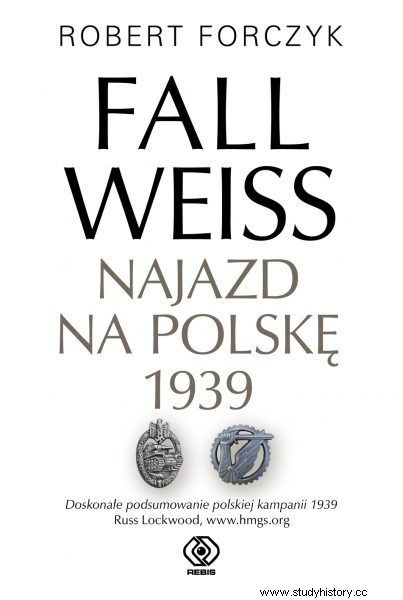
The article is an excerpt from Robert Forczyk's book Fall Weiss. The invasion of Poland 1939 , which has just been released on the market by Rebis
Unfortunately, this standard story was only a version based on war propaganda and the post-war necessity to avoid conflict with the Soviet Union. In fact, Germany and the Soviet Union, acting in concert, invaded Poland in September 1939, but the Western Allies decided to recognize only Hitler's aggression. Moreover, the Allied promises to provide military aid to Poland have never been sincere and Western leaders repeatedly neglected to protect Poland's sovereignty and territorial integrity in subsequent negotiations with the Soviet Union.
Destroy Poland…
Poland was not a martyr for the cause of the Allies, but a victim of both its enemies and friends, although it paid a high price at Tobruk, Monte Cassino, Mont Ormel, Falaise and Arnhem. By signing the Molotov-Ribbentrop Pact on August 23, 1939, Hitler and Stalin played the allies on their noses. It was their intention that this diplomatic agreement would allow them to occupy the territories of other countries.
Hitler wanted to destroy Poland in order to avoid a war on two fronts in the short term and then to win a later European war against the Anglo-French coalition. Stalin, on the other hand, wanted to lead to a universal war by using German militarism as his tool to weaken the West sufficiently against the planned Soviet expansion in ruined Europe. Although Hitler and Stalin differed in almost everything, they shared a strong desire to destroy the Polish state and break the Polish spirit forever.
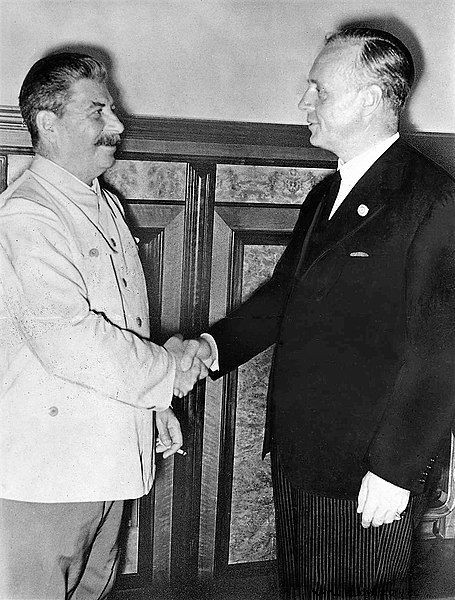
The Ribbentrop-Molotov Pact. Stalin and Ribbentrop. Moscow August 23, 1939
The Polish state, respecting education and freedom of thought, was a contradiction to their preferred totalitarian principles. The post-war claims by the communists that the Ribbentrop-Molotov Pact was a sad necessity for the Soviet Union to gain time in preparing for the inevitable clash with the Third Reich do not hold together because Stalin had the option of signing an agreement with Britain and France, but rejected it on the spot. If Molotov had signed a pact with the Allies, Hitler would face the prospect of a two-front war that Germany could not afford in 1939–1940.
A pact with the Allies would also give the Soviet Union time to prepare, but without territorial gains in Eastern Europe. This is why I say that Hitler and Stalin are equally responsible for the outbreak of World War II and their secret agreement to partition Eastern Europe was the greatest criminal plot of the 20th century, a plot that brought death or slave labor to millions of people.
Secret Protocol
The quality of historical works about the fate of Poland during World War II was not positively influenced by the fact that the Western Allies did not know about the arrangements of the secret protocol signed by Ribbentrop and Molotov in August 1939, they only knew them after finding a copy in the captured German archives in 1945. Although in 1941 much indirect evidence pointed to a German-Soviet collusion to destroy Poland, the Allies did not want to seriously consider this possibility because they were afraid to annoy their new ally.
Even after the war, it was easier for English and American historians to downplay the significance of the German-Soviet collusion in the invasion of Poland and thus avoid blaming the Soviets for the outbreak of the war. Meanwhile, Soviet historians denied the existence of a secret protocol for 50 years, until August 1989.
In April 1990, the Soviet government even admitted to the Katyn massacre, that Stalin had ordered the shooting of 20,000 captured Polish prisoners. This emphasized even more the similarity of the methods used by the Third Reich and the Soviet Union to eliminate the enemies of their regimes. From the point of view of Poland, whose citizens were imprisoned by the Gestapo and the NKVD in 1939–1941, there was never any doubt that Germany and the Soviet Union were equally guilty of starting an aggressive war to destroy the Polish state.
Misconceptions
Although World War II in Europe began with an invasion of Poland, which Germany called Fall Weiss (the white variant), until recently the course of this campaign was not well described in Western historiography. Most of the historical studies depicting the entire war (for example, the works of Basil Liddell Hart, John Keegan, Max Hastings) devoted only a few pages to the Polish campaign of 1939, often limited to generalizations about the rapid breakdown of the Polish Army. Meanwhile, the German war propaganda about this campaign, whose aim was to create an image of the invincible Wehrmacht, still influences even serious works.

Polish lancer with UR anti-tank rifle
Historical research on the Polish campaign was severely hampered by several reasons. Firstly, the lack of knowledge of the Polish language and Polish sources made it difficult to use the materials of this side of the conflict. Although the Central Military Archive was evacuated to the West in 1939, it was recreated in Warsaw during the Soviet domination, which made it difficult to use until the 1990s. The second important factor influencing the Fall Weiss research is the incomplete completion of German military sources from this campaign.
Many German divisional and corps-level combat logs were damaged or destroyed in Allied air strikes. Many of the pages preserved in the archives are burned, and some of the divisional Kriegstagebücher (war logs, KTB) for 1939 have not survived at all. Due to the relative lack of official documentation and the excessive use of German sources, many misconceptions about the course of the Polish campaign persisted for decades, despite attempts to correct them. Here are the top three misconceptions about the campaign:
1. The Luftwaffe managed to destroy the Polish Air Force on the first day of the war, mostly on the ground.
2. The Polish military doctrine was stupid, outdated and too much based on cavalry, as evidenced by the charges of the Polish cavalry against German tanks.
3. The Polish Army was armed with outdated equipment and incapable of producing modern weapons.
Polish aviation
An example of the first misconception was Martin Gilbert's statement in his 1989 war history that "the air raids had destroyed most of the air force defenders at the airports." Even Donald Watt's basic work How War Came it preaches something similar. A year later, John Keegan wrote that “in the evening of September 1, most of the Polish aviation ceased to exist; many planes were taken by surprise on the ground and destroyed by the Luftwaffe. ”
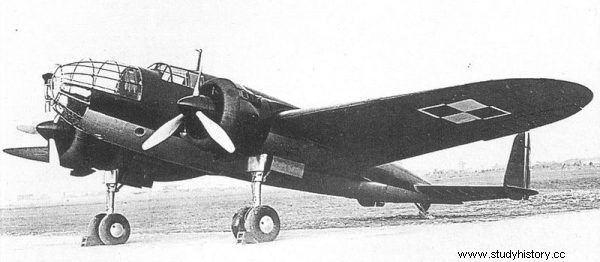
PZL.37 Łoś - bomber plane
In his monumental history of World War II, published in 1994, Gehrard Weinberg maintained that "in the first days of the campaign, the Luftwaffe swept from the sky the few modern airplanes owned by the Polish aviation." Antony Beevor reiterated claims about the destruction of Polish aviation in his 2012 WWII story, writing:"The Luftwaffe, having eliminated most of the Polish air force [on the first day], focused on close support to the Wehrmacht ground forces." In fact, the Polish air force lost only 7 percent of its operational aircraft on the first day of the war and took an active part in the fighting for a total of 17 days - until the Soviet invasion.
With a saber on the tanks?
The second erroneous view of Polish doctrine and tactics is based on German propaganda about Polish cavalrymen charging against tanks. While war historians know these claims are false, they have been repeated many times. The American historian Hanson Baldwin wrote in 1976 that "the great soldiers of the Pomeranian Cavalry Brigade died by the dozens when charging against German tanks."
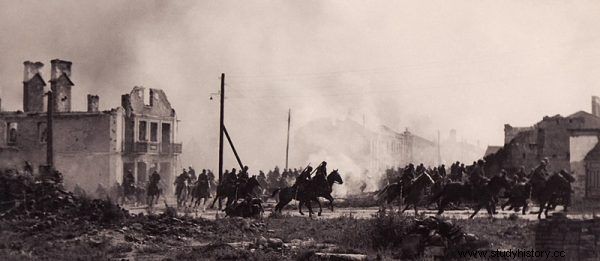
A German propaganda photo showing a scene from the film Kampfgeschwader Lützow. The photo shows the alleged Polish cavalry in Sochaczew in 1939
This myth is based on a well-documented minor skirmish at Krojanty on September 1, 1939, in which German tanks did not participate at all. Even the famous British historian Richard J. Evans stated in 2009 that "the stories of Polish cavalry squadrons madly charging German armored troops were probably made up," which sounded as if the myth was not entirely untrue. Moreover, some historians have proclaimed that even if such charges did not take place, Polish military doctrine was helpless in the conditions of modern warfare, especially against tanks and airplanes.
Obsolete Polish army ...
A third misconception about the obsolescence of Polish weapons still persists, thanks to the laziness of Western researchers. Weinberg stated that the Polish Army suffered from "a lack of modern weapons, with no possibility of producing them in Poland or purchasing them abroad." He also stated that the Polish "industry had not yet been able to produce the planes, tanks and guns necessary to stop the German attack." Beevor wrote that "a serious weakness of the Polish Army was (...) outdated weapons".
In fact, the Polish Army not only had many of the then most modern 37 mm Bofors anti-tank guns and 40 mm anti-aircraft guns, but also exported them to Great Britain in the summer of 193911. Richard Evans claimed that Poland "had few tanks and little modern equipment (...) had only 100 anti-aircraft guns to defend the entire country.
In fact, the Polish armed forces had a total of 358 modern 40mm cannons and 52 75mm anti-aircraft guns at the outbreak of the war12. The Polish 7TP light tank outperformed most of the lightly armed German tanks, and the better armed models were to go into production at the end of 1939. Models of medium tanks and heavier artillery were developed and were to enter service in 1940. The Polish Army had more tanks armed with cannons than the British Expeditionary Forces in France at the start of the war but no historian has ever described these forces as equipped with antiquated weapons.
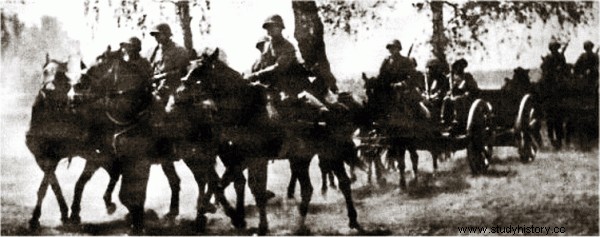
Polish artillery on the march
Polish industry built the PZL-37 Łoś bomber, which was better than the British Blenheim or the German Do 17. Polish manual machine gun wz. 28 was a modified version of the BAR (Browning Automatic Rifle) rifle that the American infantry was supposed to use until the end of the war. The only type of weapon in which the Polish side clearly gave way were modern fighters that could oppose the Messerschmitt Bf 109 Luftwaffe, but the French and Soviet aviation was in the same situation in 1939.
According to the standards of the time, the Polish Army had modern weapons, but in insufficient quantities to stop a massive invasion from two sides. Although Polish hardware difficulties are often emphasized, it is rarely mentioned that long before the war, Polish intelligence managed to break the German encrypted communication system using the Enigma machine, which was one of the great technical feats of this war. Poland handed over this secret to England for free, receiving no financial or material support for her war effort in return.
A revolutionary Wehrmacht?
Meanwhile, the actions of the Wehrmacht in Poland are usually presented as an example of a revolution in military tactics and technology, ignoring its great dependence on the acquired Czechoslovak equipment and the fact that most of the German artillery was mounted on horseback (as in 1945). The German invasion appears on the pages of history books as an elegant operation, doomed to success, in which the armored divisions advanced at great speed, creating ticks around the Poles. In fact, three days after the start of the fighting, the Oberkommando des Heeres (OKH, Supreme Command of Land Forces) decided to modify the plan by leading the 19th Army Corps (motorized) of Heinz Guderian's armored general from the Warsaw direction to Brest-on-the-Bug.
The closing of the great ticks near Warsaw, which can be seen on many maps, in fact never happened. The famous armored divisions, often depicted as unstoppable in 1939–1940, suffered a series of tactical failures during a short Polish campaign, such as the "Kempf" Panzer Division near Mława on September 1 and the 4th Panzer Division in the Warsaw suburbs on September 9. The even more catastrophic clashes at Ruszki and Kiernozia on September 16 are not mentioned at all in the existing English-language works.
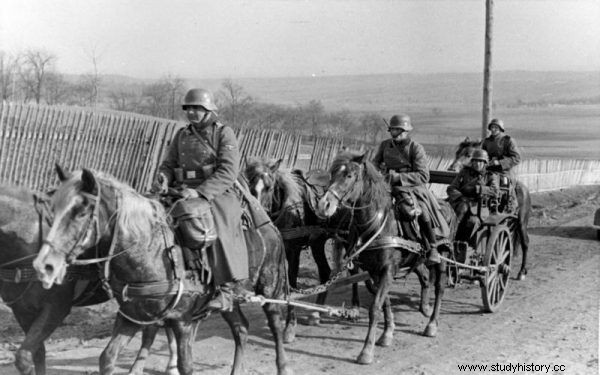
German Waffen-SS cavalry in 1939
As soon as the Germans tried to attack fortifications or cities with tanks, the results were invariably meager. Upon closer inspection of the latest works, it can be seen that Beevor, Evans, Hastings, Keegan and Weinberg relied mainly on German accounts and did not use any sources in Polish. So far, only a few historical works, such as The Polish Campaign 1939 (1985) by Steven Zaloga and Victor Madej or Betrayed Poland (2009) by David G. Williamson, have tried to provide a more balanced picture of the campaign.
The book Case White (2017) by William Russ is an invaluable source, but he focuses only on the German side and has significant shortcomings. Blitzkrieg in Poland (2008) by Richard Hargreaves is based almost exclusively on contemporary German sources and it contains a lot of war propaganda. That is why laziness or one-sided research allowed the war propaganda and stereotypes to shape the image of the Polish campaign of 1939 as something almost like a Wehrmacht victory parade.
Blitzkrieg?
Nothing has distorted the memory of German actions in Poland more than the use of the artificial term "blitzkrieg" by historians, which prioritized the meaning of technology over doctrine, tactics, organization and command itself on the battlefield. The Wehrmacht learned something about the tactics of small land and air troops from the battles of the Condor Legion in Spain in 1936–1939, but these forces were too small to serve as an example of operational activities. Therefore, the Polish campaign was a great experiment for the German Heer (land forces) and the Luftwaffe.
Many organizational issues and many methods remained unclear. At the beginning of the campaign it was not decided whether it was best to use tanks as an independent strike force or to directly support infantry units. Even the mechanized divisions were in a transitional phase; Armored divisions had too many tanks and not enough infantry, while the Leichte-Divisionen (light divisions) quickly proved to be of little use. In turn, the Luftwaffe did not cooperate with the ground troops as efficiently as the German propagandists claimed.
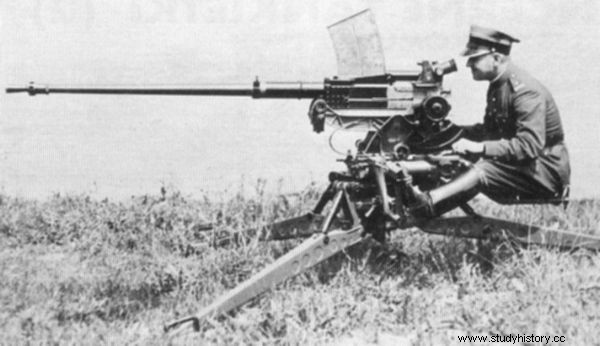
Machine gun wz. 38FK, with which the TKS were armed, was able to penetrate the armor of any type of German tank in 1939
According to modern terminology, the Wehrmacht in September 1939 was a "beta version" in which there were still many technical, operational and organizational errors. Unlike other campaigns, Heer was not a smashed army back then and had to use a jumble of police and border forces on the offensive. Senior OKH officers had well-founded concerns about the morale of the soldiers, which they reported to Hitler. Most of the German soldiers who took part in Fall Weiss did not know until the last minute that they were going to war; they were told that extended maneuvers awaited them. The marines assigned to capture the Westerplatte outpost in the port of Gdańsk took practice mortar grenades with it.
Hitler wanted to carry out a massive invasion of Poland instead of a surprising strike on Gdansk itself, as he had to make sure that the Wehrmacht was capable of quickly achieving operational goals before the great campaign against Anglo-French troops began.
War for survival
After the outbreak of the war, Poles treated the fight completely differently than their Western allies, which also contributed to the formation of erroneous beliefs. Contrary to the British, Poles did not perceive the war as a symbolic act or a sporting rivalry, but as an existential national struggle for life and death. Contrary to the war-exhausted French, the Poles did not shy away from direct combat, they often fought with great enthusiasm and were ready to go to war for the survival of the nation.
Moreover, the Poles understood from the very beginning that the enemies wanted to destroy them completely, so they fought in a ruthless manner, which often shocked the allies. Western historians had trouble answering the question why Poland simply did not yield to Hitler's demands and gave Gdańsk away as the adamant Polish national character seems to stand out from the sentiments prevailing in the West after World War I, ordering to avoid war at all costs. Unlike Neville Chamberlain, Poles understood that yielding to aggression did not save Czechoslovakia in 1938 and that Hitler could not be trusted.
Whether Poland would give up Gdańsk or not, Germany and the Soviet Union wanted to partition the Republic of Poland and destroy it anyway. Poland's behavior in the face of even the overwhelming threat was due to innate national stubbornness, understandable only to a few others. Even defeated in their homeland in 1939, Poles refused to accept defeat. Western historians were often surprised why Poles fought and suffered enormous losses even in the face of a certain defeat, such as during the Warsaw Uprising in 1944, but this stubbornness and reluctance to surrender turned out to be the basis of their later revival. Although Hitler and Stalin occupied Polish territory in 1939 and murdered thousands of Poles, they never even came close to breaking the spirit of the nation. After 50 years of brutal occupation, Poland managed to regain its freedom, and its former oppressors ended up in the dustbin of history, which proves how much persistence means.
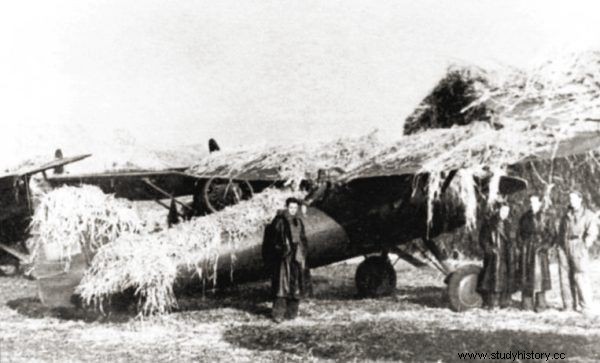
Polish PZL P.11 fighter masked at the field airfield
My intention is to study Fall Weiss from a Polish and German perspective and to extend and update the conclusions presented in Steven Zaloga's groundbreaking work 30 years ago. Although I use German and Polish sources, I try to be as impartial as possible. The mistakes made by Poles during the campaign, or the later exaggerations, will not be left unsaid. German errors will be analyzed in a similar way. However, I am not just aiming to add more military details to the story of Fall Weiss, which would only be a mere presentation of the facts. As an aspiring historian, I learned from Herodotus and other classics that the purpose of historical writing should not be simply to catalog facts, but to make a careful analysis of the causes of this and no other course of events.

The article is an excerpt from Robert Forczyk's book Fall Weiss. The invasion of Poland 1939 , which has just been released on the market by Rebis
It is also not enough to explain "why?", It is necessary to establish "what then? Why the event was important and what it will mean for future generations. Not all readers like this approach; some may wonder why I don't just jump right over to the rolling tanks and howling Stukas. However, I believe that putting the Polish campaign in its proper context means discussing the events that took place long before September 1939, as military power is not created overnight. A modern armed force is the result of many years of industrial development, doctrinal disputes, economic priorities, society's preparation and national traditions.
Likewise, the significance of historical events is not limited to a single moment. Effects of the Polish military defeat in September 1939 Fall Weiss. The invasion of Poland of 1939 and the subsequent murder of thousands of captured Polish officers by the Soviets were felt in international relations for decades.
Source:
The article is an excerpt from Robert Forczyk's book Fall Weiss. Invasion of Poland 1939, which has just been released on the market by the Rebis publishing house
